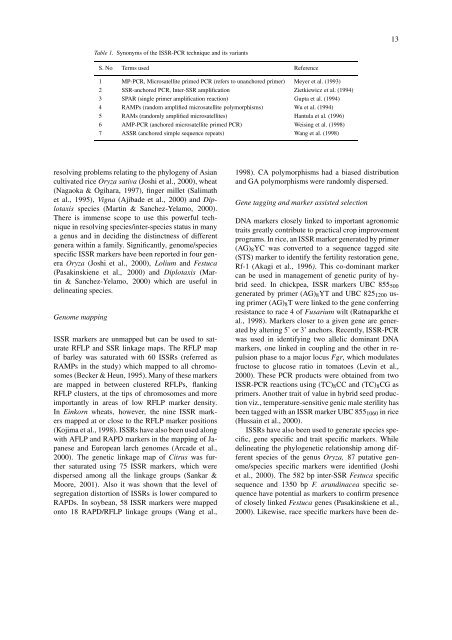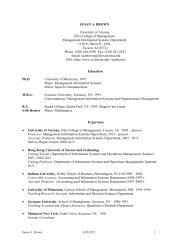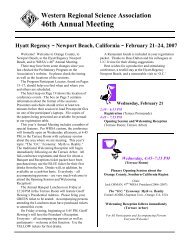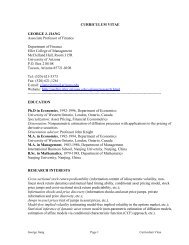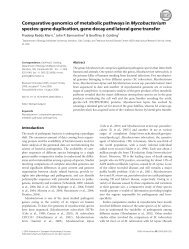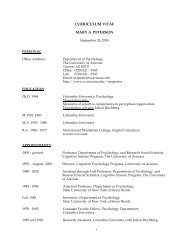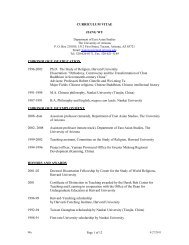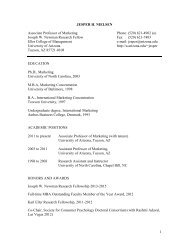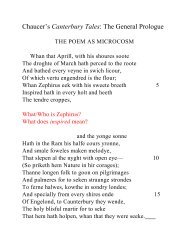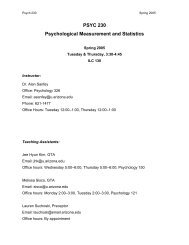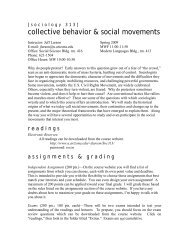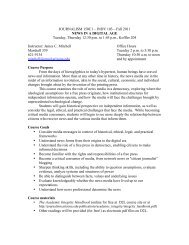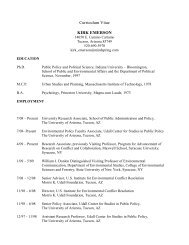Inter simple sequence repeat (ISSR) polymorphism and its ...
Inter simple sequence repeat (ISSR) polymorphism and its ...
Inter simple sequence repeat (ISSR) polymorphism and its ...
Create successful ePaper yourself
Turn your PDF publications into a flip-book with our unique Google optimized e-Paper software.
13<br />
Table 1. Synonyms of the <strong>ISSR</strong>-PCR technique <strong>and</strong> <strong>its</strong> variants<br />
S. No Terms used Reference<br />
1 MP-PCR, Microsatellite primed PCR (refers to unanchored primer) Meyer et al. (1993)<br />
2 SSR-anchored PCR, <strong>Inter</strong>-SSR amplification Zietkiewicz et al. (1994)<br />
3 SPAR (single primer amplification reaction) Gupta et al. (1994)<br />
4 RAMPs (r<strong>and</strong>om amplified microsatellite <strong>polymorphism</strong>s) Wu et al. (1994)<br />
5 RAMs (r<strong>and</strong>omly amplified microsatellites) Hantula et al. (1996)<br />
6 AMP-PCR (anchored microsatellite primed PCR) Weising et al. (1998)<br />
7 ASSR (anchored <strong>simple</strong> <strong>sequence</strong> <strong>repeat</strong>s) Wang et al. (1998)<br />
resolving problems relating to the phylogeny of Asian<br />
cultivated rice Oryza sativa (Joshi et al., 2000), wheat<br />
(Nagaoka & Ogihara, 1997), finger millet (Salimath<br />
et al., 1995), Vigna (Ajibade et al., 2000) <strong>and</strong> Diplotaxis<br />
species (Martin & Sanchez-Yelamo, 2000).<br />
There is immense scope to use this powerful technique<br />
in resolving species/inter-species status in many<br />
a genus <strong>and</strong> in deciding the distinctness of different<br />
genera within a family. Significantly, genome/species<br />
specific <strong>ISSR</strong> markers have been reported in four genera<br />
Oryza (Joshi et al., 2000), Lolium <strong>and</strong> Festuca<br />
(Pasakinskiene et al., 2000) <strong>and</strong> Diplotaxis (Martin<br />
& Sanchez-Yelamo, 2000) which are useful in<br />
delineating species.<br />
Genome mapping<br />
<strong>ISSR</strong> markers are unmapped but can be used to saturate<br />
RFLP <strong>and</strong> SSR linkage maps. The RFLP map<br />
of barley was saturated with 60 <strong>ISSR</strong>s (referred as<br />
RAMPs in the study) which mapped to all chromosomes<br />
(Becker & Heun, 1995). Many of these markers<br />
are mapped in between clustered RFLPs, flanking<br />
RFLP clusters, at the tips of chromosomes <strong>and</strong> more<br />
importantly in areas of low RFLP marker density.<br />
In Einkorn wheats, however, the nine <strong>ISSR</strong> markers<br />
mapped at or close to the RFLP marker positions<br />
(Kojima et al., 1998). <strong>ISSR</strong>s have also been used along<br />
with AFLP <strong>and</strong> RAPD markers in the mapping of Japanese<br />
<strong>and</strong> European larch genomes (Arcade et al.,<br />
2000). The genetic linkage map of Citrus was further<br />
saturated using 75 <strong>ISSR</strong> markers, which were<br />
dispersed among all the linkage groups (Sankar &<br />
Moore, 2001). Also it was shown that the level of<br />
segregation distortion of <strong>ISSR</strong>s is lower compared to<br />
RAPDs. In soybean, 58 <strong>ISSR</strong> markers were mapped<br />
onto 18 RAPD/RFLP linkage groups (Wang et al.,<br />
1998). CA <strong>polymorphism</strong>s had a biased distribution<br />
<strong>and</strong> GA <strong>polymorphism</strong>s were r<strong>and</strong>omly dispersed.<br />
Gene tagging <strong>and</strong> marker assisted selection<br />
DNA markers closely linked to important agronomic<br />
tra<strong>its</strong> greatly contribute to practical crop improvement<br />
programs. In rice, an <strong>ISSR</strong> marker generated by primer<br />
(AG) 8 YC was converted to a <strong>sequence</strong> tagged site<br />
(STS) marker to identify the fertility restoration gene,<br />
Rf-1 (Akagi et al., 1996). This co-dominant marker<br />
can be used in management of genetic purity of hybrid<br />
seed. In chickpea, <strong>ISSR</strong> markers UBC 855 500<br />
generated by primer (AG) 8 YT <strong>and</strong> UBC 825 1200 using<br />
primer (AG) 8 T were linked to the gene conferring<br />
resistance to race 4 of Fusarium wilt (Ratnaparkhe et<br />
al., 1998). Markers closer to a given gene are generated<br />
by altering 5’ or 3’ anchors. Recently, <strong>ISSR</strong>-PCR<br />
was used in identifying two allelic dominant DNA<br />
markers, one linked in coupling <strong>and</strong> the other in repulsion<br />
phase to a major locus Fgr, which modulates<br />
fructose to glucose ratio in tomatoes (Levin et al.,<br />
2000). These PCR products were obtained from two<br />
<strong>ISSR</strong>-PCR reactions using (TC) 8 CC <strong>and</strong> (TC) 8 CG as<br />
primers. Another trait of value in hybrid seed production<br />
viz., temperature-sensitive genic male sterility has<br />
been tagged with an <strong>ISSR</strong> marker UBC 855 1060 in rice<br />
(Hussain et al., 2000).<br />
<strong>ISSR</strong>s have also been used to generate species specific,<br />
gene specific <strong>and</strong> trait specific markers. While<br />
delineating the phylogenetic relationship among different<br />
species of the genus Oryza, 87 putative genome/species<br />
specific markers were identified (Joshi<br />
et al., 2000). The 582 bp inter-SSR Festuca specific<br />
<strong>sequence</strong> <strong>and</strong> 1350 bp F. arundinacea specific <strong>sequence</strong><br />
have potential as markers to confirm presence<br />
of closely linked Festuca genes (Pasakinskiene et al.,<br />
2000). Likewise, race specific markers have been de-


